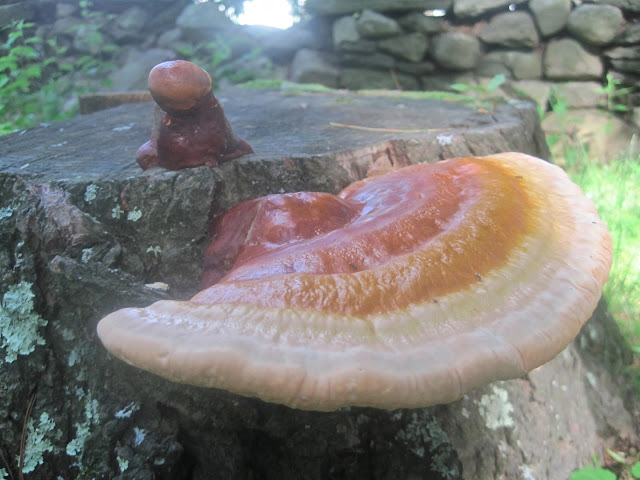 |
| Grave of Elijah Carpenter |
The inscription reads:
Mr. Elijah Carpenter
died May 19, 1808
in his 65 Year.
In his life he was a patron of piety
he had long maintained a bright
hope of a Glorious resurrection
But his death was attended
with alarming circumstances -
he SHOT himself - Psalms [?]
BESTILL AND KNOW THAT I AM GOD
Also Saml Carpenter
son to the above died May 14
1813 in his 16[?] Year.
I have never seen a stone that acknowledged the deceased's suicide before, and I certainly never expected to find one in an old New England graveyard such as this one. Though I believe that Protestants were historically more forgiving of suicide than Catholics were, I would still expect that they would view it as a sin. Even if they did allow victims of suicides to be buried in their cemeteries, I wouldn't expect an explicit reference to the cause of death on the stone.
Yet the reference is there, and is part of an inscription that suggests not a small amount of compassion and sympathy for the man on the part of his family or community. Clearly, his death was shocking, and describing it on his grave may have provided his survivors with a way of gaining psychological control over what happened - if they couldn't change it, they could at least explain it in their own words. However, it seems clear that the people responsible for the inscription didn't want the manner of Elijah Carpenter's death to completely overshadow the piety of his life.
Yet the reference is there, and is part of an inscription that suggests not a small amount of compassion and sympathy for the man on the part of his family or community. Clearly, his death was shocking, and describing it on his grave may have provided his survivors with a way of gaining psychological control over what happened - if they couldn't change it, they could at least explain it in their own words. However, it seems clear that the people responsible for the inscription didn't want the manner of Elijah Carpenter's death to completely overshadow the piety of his life.
Then there is the top of the stone. It has been extensively broken and repaired, and the stone has been reset on a new base. Could someone have inflicted the damage intentionally? Someone with a bit less sympathy for Elijah Carpenter's plight than the people who erected the stone? Or am I reading too much into this?
 |
| Detail of Elijah Carpenter stone |
Elijah Carpenter's is not the only stone in the cemetery that describes its owner's cause of death. Mr. Moses Thomson died in 1792 "with the small pox." I wonder if he, like the original settler James Deneson, was of Scottish origin. His stone is engraved with a simple setting sun.
 |
| Grave of Moses Thomson |
 |
| Grave of Sibbel Howard |
 |
| Grave of Elizabeth Baker |
 |
| Grave of Oliver M. Shaw |
 |
| Grave of Caleb Fay |
 |
| Grave of Hephzibah and Brady Walker |
BONUS: Giant mushrooms! There are a lot of trees in the graveyard, making for a lot of shade, and the mushrooms seem to like it.
Finally, one last view of the graveyard. I recommend taking a look if you're ever in the area; there's a lot still that I didn't get to see.




I was here again the day after Christmas, and it was the first time I'd ever read Elijah's stone. When I got to "He SHOT himself," I actually gasped and cried "Oh, NO!" I do have a question--I'm trying to catalogue this (and other) cemeteries as I can, and I've come across a stone I'm having trouble with. Sadly, someone clearly used shaving cream or some other substance on it, rendering it MORE difficult for later visitors to interpret. It goes like so:
ReplyDelete____ (perhaps Faith?) E. Dau. of
Mr. Stephen ____ (appears to begin with a T or F)
Mrs Mary S _____ (appears to being with an N)
died Feb. 25 1830 (or 1880)
AE 17 Mos.
Sleep on, sweet babe, and take thy rest. God called thee home. He thought it best.
Any clues would be greatly appreciated!
I went to Find a Grave and found Jane Newell Sept 1834 to 25 Feb 1836 daughter of Stephen Newell 1796-1871 and Mary Susan Vinton Newell 1802-1873. She had 3 sisters and 1 brother.
DeleteA beautiful and serene spot. Of note, this cemetery’s stone walls were built by revolutionary war veterans. There’s also a medallion recognizing one grave as belonging to “A participant in the Boston Tea Party”.
ReplyDelete